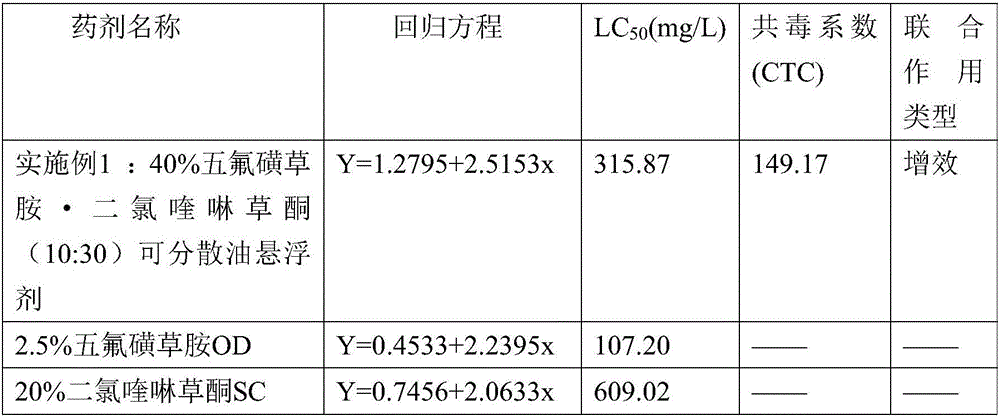Synergistic herbicidal composition
A herbicidal composition and a technology for the composition are applied in the field of pesticides, which can solve the problems of inability to synthesize branched-chain amino acids, affect weed cell division, affect protein synthesis, etc., and achieve the effects of saving control costs, improving control effects, and crop safety.
- Summary
- Abstract
- Description
- Claims
- Application Information
AI Technical Summary
Problems solved by technology
Method used
Image
Examples
Embodiment 1
[0034] Formulation example 1: 40% penoxsulam·quinclozone (10:30) dispersible oil suspension concentrate
[0035] Penoxsuam 10%, quinclozone 30%, cloclofenac 5%, castor oil ethoxylate 8%, calcium dodecylbenzenesulfonate 3%, xanthan gum 3%, silicone Defoamer 0.2%, soybean oil added to 100%. The above materials are put into a sand mill in proportion to grind, and the particle size reaches 3-5 microns, and then 40% penoxsulam·quinoxazone (10:30) dispersible oil suspension concentrate can be prepared.
[0036] Indoor activity test: According to the indoor activity test of herbicides, the co-toxicity coefficient and combined action type of Example 1 on barnyardgrass in paddy fields were measured, and the test results are shown in Table 1.
[0037] Table 1 (calculated according to active ingredients)
[0038]
[0039] According to the above test results, it is fully demonstrated that the herbicidal composition prepared by compounding penoxsulam and quinclozone is used alone with...
Embodiment 2
[0040] Formulation example 2: 10% penoxsulam·propanil (1:9) emulsifiable concentrate
[0041] 1% penoxsulam, 9% propanil, 4% isoxadifen, 4% tristyryl phenol, 8% castor oil polyoxyethylene ether, and 100% mineral spirits. After the above materials are fully mixed in proportion, 10% penoxsulam·propanil (1:9) emulsifiable concentrate is prepared.
[0042] In the indoor activity assay test, the co-toxicity coefficient and joint action type of Example 2 on rice barnyardgrass were measured, and the test results are shown in Table 2.
[0043] Table 2 (calculated by active ingredients)
[0044]
[0045] According to the above test results, it is fully demonstrated that the herbicidal composition prepared by compounding penoxsulam and propanil is compared with 2.5% penoxsulam OD or 16% propanil EC used alone. Example 2 The coordination and synergistic effect on rice barnyardgrass is remarkable, and the control effect is significantly improved.
Embodiment 3
[0046] Formulation example 3: 9% penoxsulam·milinadi (1:8) emulsifiable concentrate
[0047] 1% penoxsulam, 8% molinate, 5% isoxadifen, 6% tristyryl phenol, 6% castor oil polyoxyethylene ether, and 100% mineral spirits. After the above materials are fully mixed according to the proportion, 9% penoxsulam · molinate (1:8) emulsifiable concentrate is prepared.
[0048] In the indoor activity assay test, the co-toxicity coefficient and joint action type of Example 3 on green barnyardgrass were measured, and the test results are shown in Table 3.
[0049] Table 3 (calculated by active ingredients)
[0050]
[0051] According to the above test results, it is fully demonstrated that the herbicidal composition prepared after the compounding of penoxsulam and molinate, compared with 2.5% penoxsulam OD, or 90.9% molineate EC alone, Example 3 has a significant synergistic effect on green barnyardgrass, and the control effect is significantly improved.
PUM
 Login to View More
Login to View More Abstract
Description
Claims
Application Information
 Login to View More
Login to View More - R&D
- Intellectual Property
- Life Sciences
- Materials
- Tech Scout
- Unparalleled Data Quality
- Higher Quality Content
- 60% Fewer Hallucinations
Browse by: Latest US Patents, China's latest patents, Technical Efficacy Thesaurus, Application Domain, Technology Topic, Popular Technical Reports.
© 2025 PatSnap. All rights reserved.Legal|Privacy policy|Modern Slavery Act Transparency Statement|Sitemap|About US| Contact US: help@patsnap.com



